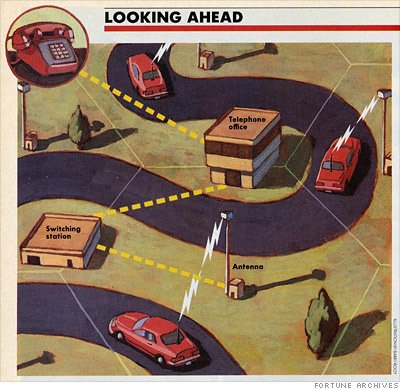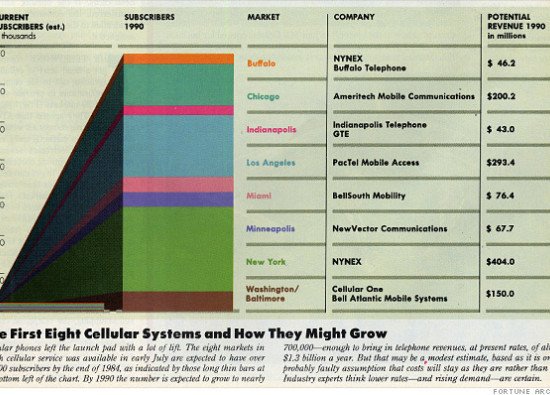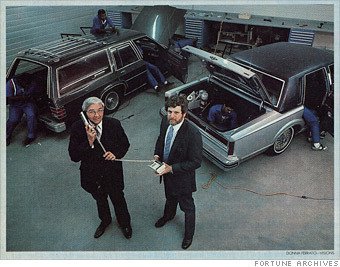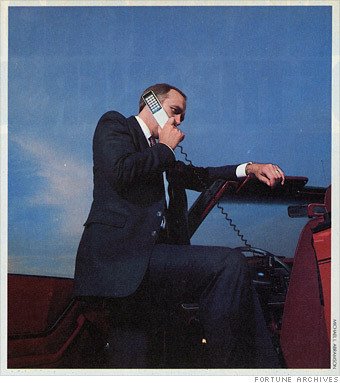《财富》经典:34年前,手机是什么样子
|
购买者争相以2500美元的价格在车中安装移动电话。专家们表示,价格必然会下降,而且需求将飙升。 |
Buyers are rushing to get cellular phones in their cars at $2,500 each. Experts say the price is sure to go down — and demand way up. |

|
《财富》——如今,美国最热门的新产业莫过于蜂窝电话——也就是安装在汽车中的电话。7月初,蜂窝电话系统已在美国8个主要都市区开始运行,包括纽约、洛杉矶、华盛顿-巴尔地摩和芝加哥,而且每周会在一个新城市上马。就算高昂的入门级电话开通费用并未下降(这种情况不大可能发生),而且在高速公路上打电话如今仍只是少数人的专利,但到1990年,这一数字将增至近100万。即便如此,这一数字也远远不足以说明蜂窝电话的巨大潜力。 到今年年底,蜂窝电话服务将覆盖美国前30个大都市区。在接下来的10年中,约有60个市场将整装待发。据估计,10年后蜂窝电话将成为年产值120亿美元的产业,其中40亿美元来自于通话收入,40亿美元为蜂窝电话销售收入,剩下的40亿美元则来自于接收和传输系统,包括天线、计算机、建筑和其他部件。 蜂窝电话系统的全球扩张可能会让这个产业的规模翻上数番。北欧国家和日本已经研制出了蜂窝系统,而且其设备制造商已经进入了美国市场。看好这一新兴产业的投资者不仅仅局限于那些服务提供商,这些服务提供商则涵盖了从电话公司子公司——Nynex、Ameritech和其关联公司——一直到MCI、华盛顿邮报和西联银行。投资者还可以对众多国际设备供应商中的早期行动者进行投资。总部位于新泽西州的Oki Advanced Communications是日本庞大的Oki Telecom Group的子公司,它在各大蜂窝设备制造商中脱颖而出,与摩托罗拉争夺美国市场头把交椅。瑞典的爱立信最近与芝加哥签订了一笔系统供应大单,金额估计高达600万美元。美国设备市场的其他主要参与者包括AT&T、Tandy和NEC。 Lehman Brothers Kuhn Loeb的电信行业分析师约翰·巴恩表示,两年前,涉足蜂窝电话产业的设备制造公司见证了自家股价的大涨。达拉斯蜂窝设备制造商Communications Systems Inc.的股价从14美元飙升至40美元,其目前的股价约为20美元/股。巴恩说,如今,蜂窝“却往往是抑郁的代名词。”这一产业需要巨大的投资,同时需要很长的时间才能产生收益。在这一过程中很多事情都可能会出现问题,包括电话因跌价速度不够快而失去对消费者的吸引力的风险。另一个可能发生的残酷事实在于:蜂窝电话是如此之受欢迎,以至于新兴的系统暂时无法满足如此大的需求,从而让潜在的用户望而却步。 如今,只有那些离不开蜂窝电话的有钱人和那些可以报销的人才能支付得起高昂的蜂窝电话服务费。设备和安装成本约为2500美元,其中包括安装在车中的电话、接收和发射装置,也就是收发器,以及一根天线。话费用因城市而异。在芝加哥,Ameritech Mobile Communications的收费标准为:基本月租费22美元,每分钟话费22-38美分(取决于通话时段),当然,长途话费得另算。在华盛顿,Bell Atlantic Mobile Systems的收费标准为月租25美元,话费每分钟27-45美分。 |
FORTUNE — The hottest new U.S. industry right now is cellular telephony — phones in cars. In early July cellular telephone systems were operating in eight major U.S. metropolitan areas, including New York, Los Angeles, Washington-Baltimore, and Chicago, and they are being switched on at the rate of one a week in other cities. By 1990 the handful of subscribers chatting away today on the expressways in those eight cities will have grown to nearly a million — even on the unlikely assumption that costs of subscribing will not have dropped from lofty introductory levels. But that scarcely measures the potential for a cellular explosion. Cellular telephones will be available in most of the top 30 metropolitan areas in the U.S. by the end of the year. Another 60 markets should be hooked up in the ensuing decade. According to some estimates, cellular will be a $12-billion-a-year industry ten years from now-$4 billion in revenues from the calls that are made, $4 billion from sales of equipment to cellular telephone users, and $4 billion for antennas, computers, buildings, and other elements of the receiving and transmitting systems. Worldwide expansion of cellular telephone systems could increase the industry’s girth manyfold. The Scandinavian countries and Japan have already hatched cellular systems, and their equipment manufacturers have leaped into the U.S. market. The investor eyeing this nascent industry is hardly confined to companies that seek to supply the service, which range from telephone company subsidiaries — Nynex, Ameritech, and their kin — to MCI, the Washington Post Co., and Western Union. Investors can also choose from an international menu of early starters among equipment suppliers. Oki Advanced Communications, the New Jersey based cellular subsidiary of Japan’s big Oki Telecom Group, vies with Motorola for first place among makers of cellular equipment. Sweden’s Ericsson recently scooped up a big contract for a Chicago system-an estimated $6 million. Other big players in the U.S. equipment market include AT&T, Tandy, and NEC. The stocks of some manufacturing companies involved in cellular “went berserk” two years ago says John S. Bain, telecommunications analyst with Lehman Brothers Kuhn Loeb. Communications Systems Inc. of Dallas, which makes cellular equipment, saw its stock go from $14 to $40 a share; the price is now riding along at about $20 a share. Right now, Bain says, cellular “is a generally depressed marker.” The business takes huge investment and the payoff will take time. Lost of things could go wrong including threat that prices won’t drop fast enough to make a phone in the car as irresistible as it sounds. Another grim possibility is that cellular might prove so popular that emerging systems would be temporarily swamped, driving potential users away. Right now only well-heeled, must-have-one individuals and those who can write it off can afford the hefty tab of cellular service. Equipment and installation cost about $2,500; that buys the handset in the car, plus the transmitter-receiver — known as a transceiver — and an antenna. Costs of the service vary from city to city. In Chicago, Ameritech Mobile Communications charges $22 per month as a basic fee for access to the system and 22 cents to 38 cents a minute, depending on the time of day. Long-distance tolls; of course, are extra. In Washington, Bell Atlantic Mobile Systems charges $25 a month plus 27 cents to 45 cents a minute. |

|
随着首批不在乎成本的用户逐渐失去对蜂窝电话的热情,移动设备制造商将面临着极大的价格削减压力。今秋,随着Tandy Corp.(一家精明的、备受欢迎的企业,通过其全国连锁店Radio Shack销售家庭电子设备)推出其首款蜂窝电话,这一压力将变得更大。Tandy的董事长兼首席执行官约翰·洛奇认为,汽车以外的商品只有在1000美元以下时才能成为热销产品。洛奇表示,Tandy的首款蜂窝电话产品标价为“数千美元”。但他还表示,“如果我对市场的预见能够在未来24个月内发生,在这个基础上价格下降一半是有可能的。”按照这一说法,设备的成本将非常接近其奇迹般的畅销价格。洛奇又补充说,“在未来两年中,我希望看到其价格每个月下降25-30美元。”这一下降幅度将健康地引导需求进一步上涨。 设备和服务的进步还可能会提升电话的销量。真正的便携式电话型号(可以放进钱包或口袋,能够在步行时使用)可能会让蜂窝电话成为当今有线电话系统的竞争对手。目前唯一能够边走边打电话的蜂窝电话由摩托罗拉制造,其售价超过了4000美元。这部电话的发明者、芝加哥软件公司Cellular Business Systems的负责人马丁·库博认为,便携式电话的价格在5年内将降至1000美元。 众多专家预测蜂窝电话还会催生大量的周边服务需求。移动电话将可以与电脑互联,接受股票走势信息、库存状况、销售订单和其他数据。这些服务可通过使用类似于各种执法车辆所安装的打印机或传真机,以影印件的形式提供。 蜂窝电话另一个可能的卖点在于:Oki正在研制一款能够与汽车电话相连的防盗报警装置。在停车时,驾驶员会在卡带上记录地点,并预设最近的警局管辖区的号码。如果有人试图盗车,电话会呼叫警察。Oki预计该设备将于明年面世,售价约500美元。 蜂窝电话服务在排名前90的市场首先推出,这些地区拥有美国74%的人口,但是蜂窝电话最终还是会覆盖那些在偏远市场生活和工作的潜在客户,例如密歇根州的巴特里克市。为了将服务扩张至人口稀疏的农村地区和小城镇,有人建议使用专用的广播卫星系统而不是电话线,来连接蜂窝系统。在宾夕法尼亚州的普鲁士王市,私营公司Mobile Satellite Corp.副总裁兼联合创始人罗伊·安德森表示,公司将蜂窝系统与卫星相连的计划将耗费“几亿美元”。但他已经集结了多个大投资商,包括Associated Communications与通用电气。他希望该系统能够在1988年面世。 蜂窝系统的工作原理十分简单:每个市场区域被划分为众多小区(也是蜂窝一词的来历);目前,一个小区的纵深可达到16英里,但也可以进一步分割。未来,随着需求的增长,一个小区可能仅覆盖某一栋办公楼。每个小区都有一根天线,能够同时接收和发射666个通话信号。蜂窝发射器的功率较低,不能远距离传输,因此会不断地反复占用频道。 |
Pressure on mobile equipment manufacturers to cut prices will be extreme as the first rush of cost-be-damned buyers subsides. The pressure will increase this fall when Tandy Corp., an adroit mass marketer of home electronic equipment through its nationwide chain of Radio Shack stores, comes out with its first cellular phones. John V. Roach, Tandy’s chairman and chief executive, believes that goods other than automobiles become mass-market items only when they cost under $1,000 each. Tandy’s first cellular products will cast “a couple of thousand,” Roach says. But he adds, “If what I think is going to happen in this market over the next 24 months does happen, half that price is possible.” That would get equipment costs very close to his magic mass-market price. Roach goes on: “In the course of the next two years I’d hope to see monthly costs drop to $25 to $30.” Such a decline should give demand a further healthy kick. Advances in both equipment and service might also hoist consumer sales. Truly portable phones-models that could be toted around in purse or pocket for use on the hoof – might make cellular a rival of today’s wired telephone systems. The only walk around cellular phone now available, made by Motorola, costs more than $4,000. Its developer, Martin Cooper, head of Cellular Business Systems, a Chicago software company, believes portables will be available for as little as $1,000 within five years. Many experts predict a hefty demand for additional over-the-telephone services. Mobile phones will be able to link up with computers to receive information on stock movements, inventory availability, sales orders, and other data. These services could be provided as hard copy, using printers or facsimile machines similar to those already used in various law enforcement vehicles. Another possible cellular attraction: Oki is working on a burglar alarm that can be hooked up to a car phone. On parking a car, the driver records the location on tape and presets the number of the nearest precinct station. If somebody tries to break in, the car calls the cops. Oki expects to put the device on the market next year for about $500. Cellular phone service will become available first in the top 90 markets, which contain about 74 percent of the U.S. population, but cellular may ultimately reach the potential customers who live and work in lesser markets, such as Battle Creek, Michigan. One scheme for spreading service into lightly settled rural areas and small towns and cities would link the cellular system with a direct broadcast satellite system instead of telephone lines. In King of Prussia, Pennsylvania, Roy E. Anderson, vice president and co-founder of Mobile Satellite Corp., a private company, says his company’s plan to link cellular by satellite will cost “a few hundred million.” But he has lined up several big investors, including Associated Communications and General Electric. He hopes to have the system working in 1988. A cellular system works fairly simply: Each market area is divided into cells (hence the name cellular); a cell is an area that at present can measure up to 16 miles across, but can be divided. Someday, as demand builds, a cell may cover only a single office building. Each cell has an antenna — capable of picking up and transmitting 666 calls simultaneously. Cellular transmitters use low power and frequencies that don’t carry far, so channels can be used over and over. |

|
随着汽车从一个小区移动到另一个小区,与发射器相连的电脑会视情况将信号从一个天线传输至另一个天线,以确保信号的强度;这种传输不会被人察觉,在不到一秒的时间内就能完成。通过增加发射器的数量和减少小区的面积,蜂窝系统可以处理无限的通话信号。 移动电话已经出现了数十年,但是它们也有缺陷,大多数都源于对该服务所分配无线电频道数量的限制。在1983年末,纽约市仅有12个频道,由630位无线电电话用户共同使用,至少有2000名用户在排队等候使用这一服务。即便是这730位幸运的用户通常也得在通话高峰期经过漫长的等待才能用上免费的通话线路。而且通话质量也很差;有时候呼叫者听起来就像是在井底打电话一样。 那些对联邦通信委员会缓慢的行事节奏并不怎么熟悉的人会惊奇地发现,蜂窝技术在十多年前便已经出现。1971年,贝尔实验室便已经发明了蜂窝系统。在经历了近10年的调查和听证会以及监管机构之间的口角之后,联邦通信委员会终于授权在两个市场进行试点,一个在芝加哥,另一个在华盛顿-巴尔地摩市场。在4年的试点工作之后,芝加哥的全套系统已于去年10月开始运行,华盛顿-巴尔地摩已于去年12月开始运行。联邦通信委员会开始全速批准更多的系统,达拉斯、底特律和密尔沃基很快将加入蜂窝大家庭。 在批准建设蜂窝系统的过程中,联邦通信委员会强制实施了多个重要的限制。首先,它规定每个市场仅能有两名运营商,其中一名运营商是当地的电话公司,或称为有线电话公司。另一名运营商便是“非有线”电话公司,之所以如此命名是因为很多潜在的运营商都拥有无线交互式无线电或传呼系统方面的背景。 之所以将每个市场或电话公司一分为二,联邦通信委员会认为,这些电话公司有良好的条件来迅速可靠地运营蜂窝系统。其他反对这种一分为二做法的申请者认为,此举为电话公司提供了不平等的竞争优势。多家非有线电话公司曾呼吁联邦通信委员会撤销这一规定,但到目前为止却一再遭到联邦通信委员会的拒绝。 非有线电话运营商不满的原因在于,电话公司在所有业务当中都处于垄断地位,因为所有的蜂窝呼叫都会接入其电话线路中。大型企业MCl’s蜂窝业务子公司正在申请前30强市场中12个市场的牌照,其总裁杰瑞·泰勒将此举与AT&T曾经在全美电话系统所享受的垄断待遇进行了对比。他说:“完全是一模一样的。电话公司希望将蜂窝系统纳入其掌控之中。” |
As a car moves from one cell to another, computers linked with the transmitters transfer signals from one antenna to another as needed to keep them strong; the transfers take place unnoticeably, in fractions of seconds. By increasing the number of transmitters and reducing the size of cells, a cellular system could handle unlimited calls. Mobile phones have been around for a couple of decades, but they’ve had a lot of disadvantages — mostly born of the limited number of radio channels assigned for this service. At the end of 1983 there were only 12 channels in New York City to be shared by 630 radiophone subscribers, with a waiting list of at least 2,000. Even the lucky 730 often had long waits for a free circuit during rush hours. And quality was poor; callers sometimes sounded as if they were at the bottom of a well. Those not familiar with the slow pace of life at the federal Communications Commission might find it surprising that cellular technology is already a teenager. Bell Laboratories had developed a cellular system by 1971. After almost a decade of studies and hearings and regulatory wranglings, the FCC finally authorized two trials, one in Chicago, the other in the Washington-Baltimore market. After four years of trials, Chicago’s full-scale system started operating last October, Washington-Baltimore’s in December. The FCC is speeding ahead with approval of still more systems, with Dallas, Detroit, and Milwaukee about ready to join the cellular club. In authorizing cellular systems, the FCC imposed several important restrictions. First, it decided that each market should be limited to only two carriers — the local telephone company, or so-called wire line company, being one. The other carrier was to be a “nonwire” company, so named because many of these would-be carriers have backgrounds in wireless two-way radio or paging systems. In setting aside half o each market or the telephone companies, the FCC reasoned that they are in a good position to get the cellular systems operating quickly and reliably. Other applicants oppose the set-aside rule on the ground that it gives the telephone companies an unfair competitive advantage; several nonwire companies have appealed to the FCC to drop the rule — which the FCC so far has repeatedly refused to do. Nonwire carriers are unhappy that the phone companies enjoy what amounts to a monopoly on all business, because all cellular calls wind up on their wires. Jerry Taylor, president of mighty MCl’s cellular subsidiary, which is applying for licenses in 12 of the top 30 markets, compares this to the monopoly AT&T once enjoyed throughout the U.S. phone system. “It’s exactly the same thing,” he says. “The phone companies would like to make cellular systems subservient to their central offices.” |

|
泰勒认为,蜂窝系统的未来取决于真正的便携式电话。“这意味着当你从纽约飞到华盛顿时,你可以随身携带电话。”泰勒还认为,所有的蜂窝电话将通过一个全国性的网络进行互联,它是一个“自成一派的世界”,在这一网络中,蜂窝电话将共享单一的区域代码。为了提升竞争,联邦通信委员会允许对蜂窝服务进行转售。例如在纽约,当前提供蜂窝服务的仅有Nynex一家公司。 Mobile Communications和西联银行都在推销其自身的蜂窝服务。西联银行将在客户汽车中安装由其子公司E.F. Johnson制作的设备,提供电话号码以及计费服务。虽然最终的服务仍由Nynex提供,但西联银行提升了其设备和服务的质量。 租车公司,例如赫兹、阿维斯和Budget等等,也都是转售商。它们从电话公司购买号码,在其车中安装设备,并将之与通话计费仪表相连,然后调高蜂窝电话车辆的租用费,并按照实际呼叫时长收取话费。在印第安纳波利斯,Budget额外征收7.5美元/天的费用,以及按50美分/分钟的价格来计算话费。其他转售商包括通用汽车的别克品牌部门,以及福特的林肯-水星品牌部门,这两个厂家在一些车型上将移动电话作为可选配置。 转售商的回报可能不仅仅是短期的。纽约独立电视电台公司LIN Broadcasting Corp.子公司LIN Cellular Communications正在等待联邦通信委员会批准其在洛杉矶提供蜂窝服务。与此同时,它还是Pacific Telesis(此前Bell公司的母公司,Bell在加州和内华达州均设有公司)子公司Pactel Mobile Access的转售商。LIN Cellular的总裁理查德·凡尔纳指出,其公司与Pactel的合同能够让客户在他们决定从Pactel转投LIN(在LIN获得经营批准后)之后依然使用原来的电话号码。这是一个重要的让步。获得移动电话号码的客户可能会将其印刷在物品或名片上。如果这一号码不能从一家公司转到另一家公司,那么客户就只能一直使用分配这一号码的蜂窝服务供应商。 各大电话公司已达成协议,在前30强市场提供服务时不会提交竞争申请,并借此抢占了蜂窝市场的先机。它们同意AT&T的7家运营公司将占据23个30强市场,而General Telephone & Electronics则占据7个。那些想要进入蜂窝领域的非电话公司之间可没有这么和睦的关系。它们因相互抢夺市场而失去了宝贵的时机。直到最近,像Metromedia, Western Union、Millicom和Maxell Telecom Plus这些在蜂窝热中涌现的知名公司才成立了它们所称的“大同盟”。根据同盟的规定,同时在联邦通信委员会的鼓励下,只有一位合作伙伴将参与投标,从而在未来60个蜂窝市场的争夺战中争取进入其中的55个市场。 尽管非有线公司仍在相互竞争,但电话公司却站了出来,并祭出了行业所称的“需求积压”策略。客户对于移动电话异常渴望,哪怕价钱再高,他们都愿意购买。例如在纽约,这样的人有数千个,很多人在Nynex系统在6月底上线之前便已经安装了移动电话。当Nynex获批之后,数百名先知先觉的客户开始排起了长队。Potamkin(卡迪拉克和丰田经销商)曼哈顿分公司的蜂窝电话安装业务经理巴特·罗宾斯称,“这座城市成为了一个动物园。”在系统运行后的第一天快要结束时,罗宾斯感到恼火不已。“所有人都想争当第一。我、我、我。” 运营商也希望成为第一个。在获批运行蜂窝服务之前,Nynex曾经历了数次延期。Nynex Mobile的总裁摩根·肯尼迪回忆道,当联邦通信委员会最终向公司位于纽约珍珠河的总部发话,允许公司开展这一业务时,一名雇员像“保罗·李维尔”那样一边喊着新闻,一边绕着办公司奔跑。然后所有人都走出了办公室,并打开了香槟酒。 非有线系统公司Cellular One在华盛顿-巴尔地摩市场抢占了短暂的市场先机,它在那里的竞争对手是Bell Atlantic 子公司Bell Atlantic Mobile Systems。Cellular One董事长维恩·舍勒认为,充当头鸟相当于“每个月约2%的市场份额”。他说,这一计算结果催生了Cellular One公司,它是处于竞争关系中的非有线电话公司所成立的首个意义非凡的合资公司。 当舍勒在1982年申请华盛顿牌照时,他所执掌的公司更名为American Radio Telephone Service(ARTS)。ARTS最初是一个传呼机公司,曾作为蜂窝服务试点运营了4年。当时还有四家竞争公司:华盛顿邮报、Metromedia、另一家传呼机公司Metrocall以及蜂窝咨询公司Metropolitan Radio Telephone System。 ARTS与Post的蜂窝业务合并了,此举将竞争对手的数量降到了1个。舍勒说:“我们认为合资企业将我们的经验与他们不俗的团队规模以及在通信领域的敬业精神很好地结合起来。”但联邦通信委员会的动作十分缓慢,同时也在慎重考虑其他三名竞争者的申请。“我开始担心我们所拥有的优势,也就是4年的试点,无法与Bell Atlantic所获得的市场先机相媲美。” 因此,他开始思考进行进一步的整合。9月,他将其在ARTS-Washington Post的股份出售给了Metromedia,以换取现金和其部分业务。Cellular One得以成立,并获批成为了华盛顿-巴尔地摩市场的非有线运营商。公司的系统于12月开始运行,较Bell Atlantic早了4个月。一场营销大战接踵而至,但舍勒称,他所抢占的市场先机确实带来了回报,Cellular One斩获了3000个用户,而Bell Atlantic大概只有600个。 蜂窝设备制造商同样面临着竞争困境。这场竞争将变得尤为激烈,因为产品基本上没有差异化可言。真正发挥作用的是推销技巧。移动电话制造界的大哥大摩托罗拉在自家后院丢失了一块领地,当时,爱立信一举夺得Rogers Radiocall的转换站修建合同。Rogers Radiocall是metromedia的子公司,也是Ameritech在芝加哥的竞争对手。 |
Taylor believes that cellular’s future lies with truly portable phones. “That means that when you fly from New York to Washington, you’ll be able to take your phone with you.” Taylor also believes that all cellular phones will be interconnected through a national network — “a universe unto itself’ where cellular phones would share a single area code. To increase competition, the FCC allows resale of cellular service. In New York, for example; where cellular currently is provided only by Nynex. Mobile Communications, Western Union advertises its own cellular service. Western Union will install equipment made by its E.F. Johnson subsidiary in the customer’s car, provide a telephone number, and do the billing. Though the actual service comes through Nynex, Western Union pushes the quality of its equipment and service. Rent-A-Car companies – Hertz, Avis, National, and Budget among others – are also resellers. They buy number from the phone company, install equipment in their cars, and hook up meters that tick away as calls are made – local calls only, thank you, except with telephone credit cars – and then charge customers a premium for the privilege of driving a car with a cellular phone as well as for calls actually made. In Indianapolis, Budget charges a premium of $7.50 a day, plus 50 cents a minute for use of the phone. Other resellers include GM’s Buick division and Ford’s Lincoln-Mercury division, both of which offer mobile phones as optional extras on some models. The resellers’ rewards may be more than short term. LIN Cellular Communications, a subsidiary of New York’s LIN Broadcasting Corp., an independent TV and radio company, is waiting for FCC permission to provide cellular service in Los Angeles. In the meantime, it is whiling away the time as a reseller for Pactel Mobile Access, a subsidiary of Pacific Telesis, parent of the former Bell operating companies in California and Nevada. LIN Cellular President Richard Verne points out that his company’s contract with Pactel allows customers to take their phone numbers with them should they decide to switch from Pactel to LIN after LIN gets the nod to start service. That is an important concession. A customer who gets a mobile number is likely to print it on stationary and business cards. If the number can’t be transferred, the customer is all but handcuffed to the cellular supplier that assigned it. The telephone companies got a head start in cellular by agreeing not to file competing applications to provide service in the top 30 markets. They agreed that AT&T’s seven operating companies would take 23 of these top markets and General Telephone & Electronics seven. No such amity ruled among nontelephone companies wanting to get into cellular, and they lost precious time scrapping with one another for markets. Only recently have such companies as Metromedia, Western Union, Millicom, and Maxell Telecom Plus – all prominent in the rush for cellular – got together in what they call “the grand alliance.” Under this alliance, encouraged by the FCC, only one partner will bid for a place in 55 of the next 60 cellular markets. While the nonwire companies were still scrapping, the telephone companies rushed forth to snare what the industry calls “pent-ups” — customers so eager for mobile phones that they’ll pay almost any price to get them. In New York, for example, there were hundreds of them, many with phones installed weeks before the Nynex system was switched on in late June. When Nynex got approval, hundreds of early-bird customers began to line up. “This city’s a zoo,” exclaimed Bart Robins, manager of cellular installation at a Manhattan branch of Potamkin, a Cadillac and Toyota dealer. By the end of the first day after the switch-on, Robins was exasperated. “Everybody’s got to be first. Me. Me. Me.” The carriers want to be first too. Nynex was subjected to a number of delays before it was allowed to switch on cellular service. When the FCC finally sent word to the company’s Pearl River, New York, headquarters, that it was okay to go ahead, one employee ran around the office shouting out the news “like Paul Revere,” recalls Morgan J. Kennedy, Nynex Mobile’s president. Then everybody went out and drank champagne. Cellular One, a nonwire system, got a brief head start in the Washington-Baltimore market, where it competes with Bell Atlantic Mobile Systems, a subsidiary of Bell Atlantic. Wayne Schelle, chairman of Cellular One, figures being the early bird is worth “about two percentage points of market share a month.” This calculation, he says, led to the formation of Cellular One, the first significant joint venture among competing nonwires. When Schelle bid for the Washington license in 1982, the company he headed was named American Radio Telephone Service. ARTS, originally a beeper company, had operated a trial cellular service for four years. There were four other contenders: the Washington Post Co.; Metromedia; Metrocall, another paging company; and Metropolitan Radio Telephone System, a cellular consulting firm. ARTS and the Post’s cellular business merged, which cut the number of competitors by one. “We thought that the joint venture gave us a good combination, our experience and their big league size and commitment to communications,” says Schelle. But the FCC was moving slowly, ponderously mulling the applications of the three contenders. “I began to worry that the advantage we had, the four-year trial period, would be lost to a head start by Bell Atlantic.” So he began to think of some kind of further merger. In September, he sold the ARTS-Washington Post partnership to Metromedia for cash and part of the business. Cellular One was formed and won approval as the nonwire operator in the Washington Baltimore market. The company’s system began operating in December, four months ahead of Bell Atlantic. A marketing battle has ensued, but Schelle claims that the head start he gained has indeed paid off — Cellular One has 3,000 subscribers to an estimated 600 for Bell Atlantic. Manufacturers of cellular equipment also face a competitive struggle. Competition will be especially tough because there is little to differentiate products. Salesmanship makes the difference. Motorola, the dean of mobile telephony, lost a piece of business in its own backyard when Ericson snatched the contract to build a switching station for Rogers Radiocall, a metromedia subsidiary and Ameritech’s Chicago competitor. |

|
Oki在美国市场将摩托罗拉甩在了身后。Oki美国业务董事长兼首席执行官马尔·古里安坚持认为,“我们是业界第一”。“我们的市场占有率超过了50%。”摩托罗拉对这一说法持不同意见。然而,Oki在美国的业务做的相当好。公司与纽约Nynex达成了系统设备提供独家协议,同时还达成了另一项协议,为Southwestern Bell提供99%的设备。公司还与Bell Atlantic和Pactel达成了非独家协议。事实上,Oki的迅速成功几乎使自身陷入了困境,有一段时间,公司的供货无法跟上其产品的需求。如今,古里安表示,Oki的首家美国工厂正在满负荷运转,里面满是机器人,位于乔治亚州的诺克罗斯。 事实上,使用Oki设备的实际客户数量可能超出了其设想。移动电话行业中的黑市似乎一片欣欣向荣。古里安表示,他不断地看到和听到一些有关Oki设备的广告,“制作这些广告的厂商我们从来都没有听说过。”他说,这些广告在纽约、迈阿密和洛杉矶到处都是。他还指出,“我试图找出这些厂家都是从哪获得的设备,但结果令人抓狂。”当然,能够在黑市大量出现的产品必然有着不俗的市场前景。(财富中文网) 译者:冯丰 |
Oki sees itself as outstripping Motorola in the U.S. market. “We’re No. 1,” insists Mal Gurian, chairman and chief executive of Oki’s U.S. operations. “We have more than a 50% market share.” Motorola disputes the claim. But Oki is doing very well. The company has an exclusive agreement to provide New York’s Nynex system with equipment, and another to provide 99% of Southwestern Bell’s. It also has nonexclusive contracts with Bell Atlantic and Pactel. In fact, Oki’s quick success nearly swamped it, and for a while the company was unable to keep pace with demand for its products. Now, Gurian says, Oki’s first U.S. facility, a robot filled factory in Norcross, Georgia, is in full production. In, fact, Oki may be supplying more customers than it wants to. A black market already seems to be flourishing in mobile phones. Gurian says he keeps seeing and hearing advertisements for Oki equipment “place by people we’ve never heard of.” The ads have shown up, he says, in New York, Miami, and Los Angeles. He adds: “It’s driving me crazy trying to find out where they’re getting the equipment.” A product that spawns the black market clearly has good prospects. |













